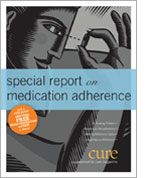What if the Medication is Too Expensive?
Helping patients pay for their cancer mediation can improve compliance.
Many patients are overwhelmed when facing a cancer diagnosis. The second shock may be from the sticker price of treatment.
Even patients with insurance may be underinsured or face high out-of-pocket costs, especially if they need an oral medication as opposed to one delivered intravenously.
“Many patients are having trouble paying for their oral drugs,” says Erin Moaratty, chief of mission delivery at the Patient Advocate Foundation. A healthcare plan could require a co-pay for oral chemotherapy and also may have a cap on annual benefits. A copay of 20 percent can result in an astronomical sum: $1,800 out of pocket for a $9,000-a-month pill.
Some states require health insurers to cover oral chemotherapy at the same reimbursement rate as intravenously administered treatment, but not every state has such a law. Unfortunately, the Patient Protection and Affordable Care Act does not address this issue, Moaratty says.
Anthony Lacey, a Maryland real estate agent, was barely able to cover the monthly $7,000 tab for his wife’s nine months of oral chemotherapy before she died of metastatic breast cancer in 2011. Because doctors could not find a similarly effective IV option, he exhausted his daughters’ college fund and now must sell his home. As devastating as the experience was, Lacey was committed to helping others in the same boat. He helped push for a new law in his home state of Maryland that resulted in oral chemotherapy being covered to the same extent as intravenous drugs. At least he has the knowledge that his fellow Marylanders will not face the dilemma that he did.
Medicare patients can also get caught in the “doughnut hole”—they have spent $2,800 on prescription drugs that are covered by Medicare—but it won’t kick in again until $4,550. Until then, the financial burden is theirs.
A patient may decide that the only solution is to cut back on doses. Doctors would prefer a frank conversation about payment problems as they can explain that reduced doses may limit or negate the effect of therapy. In addition, physicians may have resources they can offer to help patients pay for their treatments. Pharmaceutical companies often have patient assistance programs for those who meet certain criteria, such as a fixed income and few resources. Doctors, nurses or a patient navigator or social worker on staff can help steer patients to the right drug company contact, as can patient-oriented organizations, such as the Cancer Support Community.
Financial aid may also be available from the American Cancer Society or a cancer group that supports patients who have a specific cancer type.
Physicians might also have treatment alternatives that are less expensive. “If there’s no way to procure the medication without the patient purchasing it, it’s up to me to make a substitution,” says Lidia Schapira, an oncologist at Massachusetts General Hospital in Boston. “Most of the time I can find a drug that is cheaper, and I do so.”
There are several organizations, companies and institutions that offer financial help to patients for treatment costs. Visit curetoday.com/toolbox.
